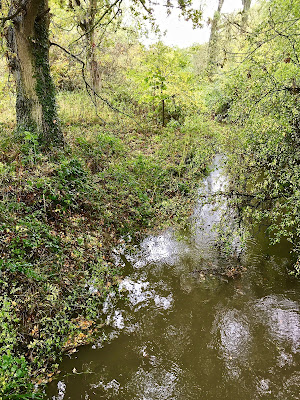October this year has, although variable, been a typical autumn month, starting cool, bright and breezy with good amounts of rainfall. The river was soon running faster and higher, showing signs that the Millpond at Warnham was being replenished with the water flow spreading out and moving the river bed silt, not just flowing over the shallows. During the first week chiffchaffs were still present and making contact calls in most dense thickets on the banks. The ground became very damps with robins, blue ts, great ts, house sparrows and blackbirds foraging for invertebrates. on the surface. Lower down the ground remained dry.
Fine continuous rain during the second week gave way to a fine day on the 9th. After a cold night, bird activity suddenly increased. The first sign was a Water Shrew which had been hunted and caught by a raptor but then suddenly dropped onto the ground when the bird found it completely unpalatable.
Two groups of goldfinches were singing in separate thickets whilst blue ts, great ts, and nuthatches moved quickly through the trees. Robins and a Dunnock were sifting through the layers of earth on the ground where leaves had blown aside.
Several Speckled Wood butterflies were seen chasing and spiralling as well as Large Whites. Numerous house sparrows were present in a group on the riverbank vegetation but amongst them a stranger - a tree sparrow, clearly seen preening for quite a while in a bare tree. The differences were clear but maybe it was just odd plumage colouring ....no sign of it since then.
It was mid-October before wrens started to sing again. They had been present but very elusive working their way amongst the mossy roots and tree trunks on the banks. Dunnocks were seen too but favoured pathways rather than muddy slopes., springing out from hedges onto paths where they could see invertebrates crossing. or warming up. A kestrel was seen flying west in a north wind on 14th then on 18th a common buzzard was seen landing after a cold start to the day. Before then, on 17th, robins, house sparrows, two wrens, a green woodpecker (on ant-heap area) , two chiffchaffs chasing, blue ts, great ts, and a calling goldcrest and groups of singing goldfinches were seen in various locations along the banks.
By 24th it had become windy but remained warm. On 25th October, the day of our meet, we were caught in a hailstorm - a great spotted woodpecker had been heard calling loudly in the warm sunshine before the deluge, although the green woodpecker, the 'rain bird' was silent. The hail had cooled the atmosphere and the weather was mostly colder, wetter and more windy for the rest of the month,


